
 |
| Welcome | About Me | People | Research | Curriculum Vitae | Japanese version (日本語ページ) |
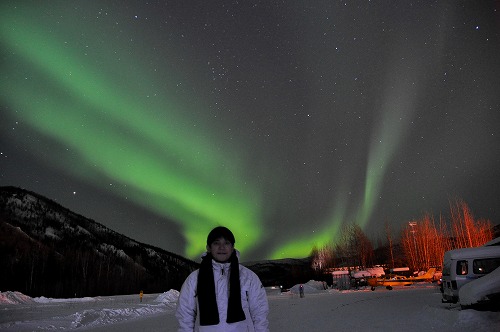 |
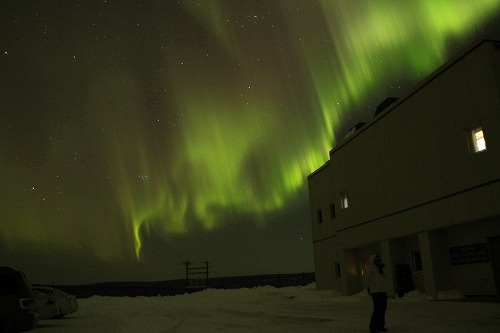 |
| Toshi under aurora in Alaska. Photos by X. Xing and N. Ozak |
| Toshi Nishimura's group at the Department of Atmospheric and Oceanic Sciences of UCLA studies Earth's auroral physics including magnetosphere-ionosphere coupling, plasma and electromagnetic energy transport, wave-particle interaction for diffuse aurora, and coupling to the thermosphere. We primarily take integrated observational approach to understand the system response to solar wind energy input into the magnetosphere-ionosphere-thermosphere. The dataset includes all-sky imagers, incoherent and coherent scatter radars, ionospheric and magnetospheric satellites, and ground magnetometers. |
| Name | Yukitoshi (Toshi) Nishimura |
| Affiliation | Department of Atmospheric and Oceanic Sciences, University of California, Los Angeles |
| Job title | Associate Researcher |
| Office | Math and Sciences 7115 |
| Toshi Nishimura graduated the Department of Geophysics, Tohoku University, Japan in 2009. He was a JSPS Research Fellow at the Nagoya University, Japan until 2011, and he came to UCLA initially as a visiting scholar and now he is an assistant researcher. He received Student Paper Awards at 2006 AGU Fall Meeting and 2007 SGEPSS Fall Meeting. He also received an Obayashi Young Scientist Award in 2014. His primary research interest is auroral physics particularly on auroral substorms and pulsating aurora from the magnetosphere-ionosphere coupling perspective to identify electromagnetic energy transfer processes in the Earth's magnetosphere-ionosphere coupling system, a fundamental topic for understanding plasma transport and energization, using observations in space and on the ground. He identified the sequence of events leading to substorm auroral onset, which had been a long-standing debate over 40 years in the magnetosphere-ionosphere coupling community and became a potential resolution to a long-standing debate in the substorm community. This work was selected as a NASA Press Release. |
| He has also investigated the cause of a certain type of aurora, called pulsating aurora. Although different wave modes had been discussed in the community, he uniquely determined by using a cross correlation method that the lower band chorus waves are the mode of waves for driving pulsating aurora. This discovery has been published in the journal Science and highlighted by news media. His research has been supported by 12 grants from NASA, NSF and JSPS, and his research led to more than 80 refereed papers. His research vision is to pursue coupling processes across different regimes in the Magnetosphere-Ionosphere-Thermosphere system, including coupling among the dayside-plasma sheet-inner magnetosphere using new high-resolution imaging in the polar region, and coupling to the upper neutral atmosphere by combining satellite observations and numerical simulations. |
| He currently supervises two graduate students and two postdoctoral scholars. They study auroral physics in the dayside ionosphere, polar cap, and nightside auroral and subauroral regions for understanding the structure and evolution of fast transient plasma flows and their influence on magnetospheric structures. Bea Gallardo-Lacourt received a First Place Prize at the 2014 CEDAR workshop for having the best student paper, and an Outstanding Student Paper Award at 2014 AGU Fall Meeting. Ying Zou received Jacob A. Bjerknes Award from UCLA for academic excellence. He has also worked with two undergraduate students at UCLA, one from the Mathematical department and the other from the Physics department. |
| Please see my CV for more detailed information about myself. |
 |
Larry R. Lyons | Distinguished Professor | Flow burst dynamics |
 |
Toshi Nishimura | Associate Researcher | Substorm precursors, day-night connection, diffuse aurora |
 |
Ying Zou | Postdoctoral Scholar (2015-) | Polar cap airglow patches/arcs and their connection to nightside aurora |
 |
Beatriz Gallardo-Lacourt | Postdoctoral Scholar (2016-) | Auroral streamers and subauroral flows |
 |
Boyi Wang | Graduate Student (2013-) | Dayside aurora and patches |
| Cheng Zhen | Graduate Student (2015-) | Ionosphere-thermisphere coupling |
Substorm is the most dynamic and specutacular phenomenon in auroral phenomena, which can be seen with naked eyes. While the phenonenology has been well documented, the time sequence leading to substorm onset has been a long-standing debate for more than 40 years in the space physics community. We found precursor of auroral substorms using the THEMIS all-sky imager network. The pre-onset sequence starts from the poleward boundary of the auroral oval leading to faint auroral streamers toward the equatorward boundary, suggesting enhanced earthward plasma flows in the magnetosphere. This result was selected as a NASA press release and published in JGR. 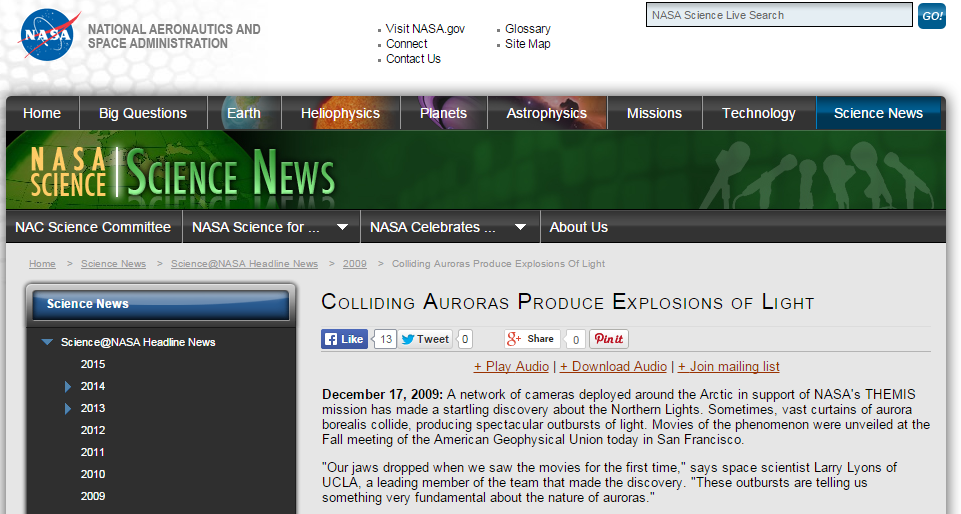 The substorm event list is available from here (excel format). |
Pulsating auroras are beautiful emissions that blink in the atmosphere with a periodicity of 5 to 40 seconds. Earlier work in October, based on observations both from NASA's THEMIS spacecraft and from the ground, we solved the mystery of how the pulsating auroras were formed -- these spectacular light shows were driven by chorus waves observed deep in space. The lessons we are learning from this novel experimental technique is links aurora in the ionosphere to a location which is separated by over 40,000 km in the magnetosphere. This work was published in Science and covered by News media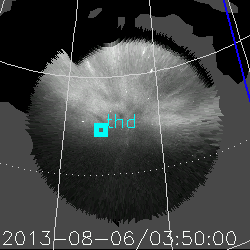
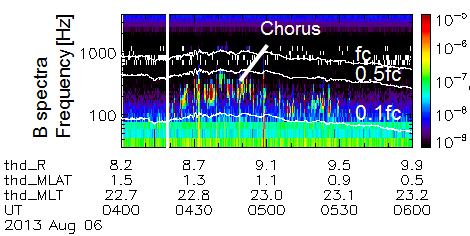 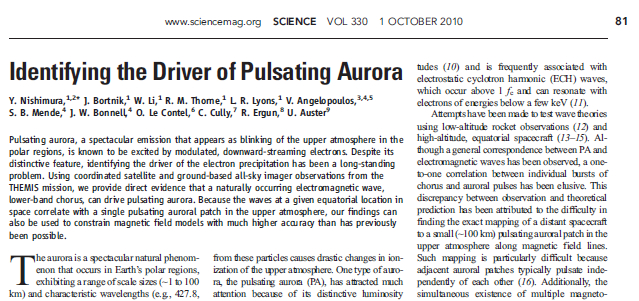  |
Another big question regarding substorms is to understand the nature of waves that occur at the very beginning of substorm onset. Bea Gallardo-Lacourt used a high time resolution mode of SuperDARN radar data together with THEMIS all sky imager data and discovered large-amplitude oscillatory flows. Those flows are found to highly correlate with auroral waves buth with a finite phase lag. Through a careful examination of four events with different beam configurations, she determined the spatial relationship between ionospheric flows and upward field-aligned currents during the initial stage of substorm onset. This work was published in JGR and was selected as a Featured Article. She received a Student Poster Award in the 2014 CEDAR Workshop.
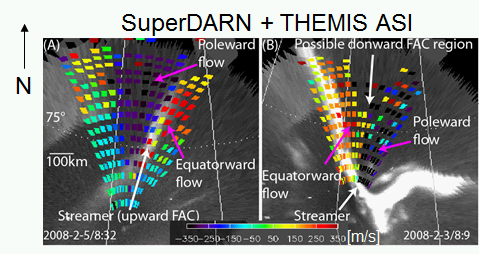 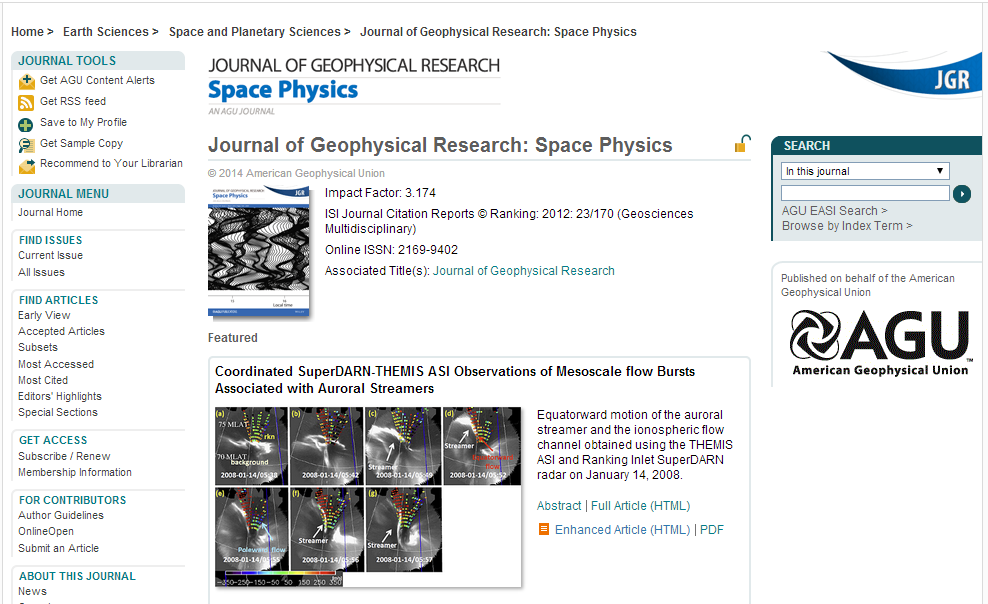 |